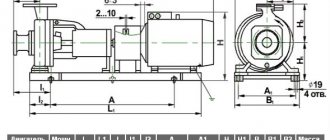Blood pressure is an indicator related to constant changes. It changes at certain times of the day and increases after physical activity and stressful situations. Tonometer readings of 120/80 are considered normal values around the world, but they can deviate by several units in one direction or another, depending on age, lifestyle and the individual characteristics of the human body. What to do if the tonometer increasingly records pressure as 120/100? What causes this condition and whether it needs correction, we need to understand in more detail.
What pressure is considered normal?
A person’s blood pressure has two indicators - the upper (systolic), recorded at the moment the heart contracts, and the lower (diastolic), noted when the heart relaxes and pushes blood into the arteries. When the heart and capillaries are functioning normally, the tonometer readings are within 120/80 or 110/70; a slight deviation up or down is not considered a pathology.
For each person, the pressure is individual, but, in addition to fixing the two indicators, it is necessary to monitor the difference between them. This difference is called pulse pressure and can also indicate existing health problems. Changes in tonometer readings are affected by:
- Times of Day;
- nervous tension, stress;
- physical exercise;
- binge eating;
- alcohol consumption;
- taking certain medications.
If, after an unexpected increase in blood pressure (BP) levels, the indicators stabilize on their own, and the fact of jumps is rarely observed, there is nothing to worry about. The normal difference between the upper and lower limits should be from 35 to 55 mmHg, and a regular decrease in this indicator indicates the development of cardiovascular pathology.
Why is high renal pressure dangerous?
If the kidney pressure is not normal, then this indicates that the heart is pumping blood intensively, which was facilitated by certain changes. Moreover, when only diastolic blood pressure is high, then most likely this indicates a malfunction of the vascular and circulatory system.
If the blood cannot perform the functions assigned to it, then this will certainly affect the blood vessels. And under such conditions, the entire system slowly wears out, as a result of which a stroke or heart attack often occurs.
In addition, constantly high lower blood pressure leads to the formation of vascular atherosclerosis. With this disease, the vessels become inelastic, the causes of this condition are a violation of lipid-protein metabolism.
As a result, cholesterol is deposited on the vascular walls and plaques form. At the same time, the passage of blood is complicated, so the vessels can become clogged.
It is worth noting that the condition of blood vessels depends on renin, a substance produced by the kidneys. Therefore, if the lower pressure numbers are too high, then the person has kidney problems.
An unhealthy lifestyle, including bad habits, does not allow the kidneys to fully perform their work, which affects the condition of the entire body. Due to the deterioration of contractility, blood stagnation occurs, so such reasons lead to the development of cardiovascular failure.
And if proper treatment is not carried out, intellectual and memory impairments will occur in the brain.
The causes of kidney failure are changes in the kidneys, so they do not perform their functions regarding the elimination of toxic substances, as a result of which the body is gradually poisoned.
It is necessary to distinguish the norm from the disease
If a person regularly sees a blood pressure of 120/100 during measurement, he should visit a cardiologist. Despite a slight deviation in the normal pulse pressure, this is a demonstration of the onset of pathological changes in the condition of the heart and blood vessels. A constant departure of the lower indicator beyond normal limits, while the upper one remains unchanged, indicates the possible presence of the following problems:
Why does blood pressure jump during menopause?
- sclerotic changes in the capillary system;
- diseases of the renal system;
- hormonal imbalances;
- diseases of the spinal column;
- elevated blood sugar levels;
- problems with the thyroid gland.
Blood pressure of 125/100 and even 130/100 should not frighten a person if it appears once after hard physical work, as a result of stress or mental overstrain. Therefore, in such a situation, it is important to separate a single jump in tonometer readings from the first signs of a developing disease. It is not possible to do this on your own; if your diastolic pressure constantly increases, you should consult a specialist and undergo an examination.
What to do if the pressure is 110 over 90
Without medical observations and a thorough examination, it is impossible to determine why diastolic pressure is high. If the lower pressure is increased, this is recorded repeatedly, the pathology must be treated. Many patients begin to take medications thoughtlessly. Taking a one-time pill is not a solution to the problem. Medicines are prescribed by a doctor after determining the cause of the high diastolic value. A sharp deviation in indicators may indicate oncological processes and other dangerous diseases.
Reasons for a sustained increase in diastole
What does pressure 120/100 mean if the lower reading is constantly elevated? Doctors warn about the danger of developing isolated diastolic hypertension when only the lower reading fluctuates. A similar diagnosis is made if the tonometer readings are constantly recorded: the upper one is below 140, and the lower one is above 90.
Previously, doctors believed that it was important to control only systolic pressure, and diastolic pressure was not so important, but later the importance of both marks was confirmed. Isolated diastolic hypertension often goes unnoticed, because a person does not feel the severe symptoms inherent in the disease. It is sometimes possible to detect jumps in the lower numbers only during routine examinations by a cardiologist.
A steady increase in the lower pressure threshold is noted for a number of reasons:
- kidney disease (most often chronic glomerulonephritis) - in this case, the vessels in the renal system undergo destructive changes. The veins and arteries located there narrow, causing an increase in lower pressure;
- malignant and benign neoplasms in the kidneys - they provoke a constant release of adrenaline into the blood plasma, which is why the diastolic indicator is always elevated;
- problems with the endocrine system - observed in women during menopause, pregnancy, as well as in patients with thyroid pathologies (hypothyroidism, hyperthyroidism, diffuse goiter);
- Essential hypertension is a condition in which an increase in diastolic pressure is provoked not by existing diseases, but by a general poor emotional or physical state of the body. Often, doctors cannot determine the true cause of blood pressure surges until they conduct a full examination of the body.
Why might a person still exhibit signs of isolated diastolic hypertension? Unfavorable factors affecting the condition of the heart and blood vessels include excess weight, poor diet, lack of a good night's rest, psycho-emotional and physical stress.
Unfortunately, if a person’s blood pressure becomes normal at 120/100, doctors may suspect the development of atherosclerosis.
How to reduce the lower pressure of 125 to 95?
When the upper value of 125 mmHg and the lower number of 95 mmHg are displayed on the tonometer screen, measures can be taken to lower the lower reading.
The first thing to do is calm down. A nervous environment will only increase blood pressure. It is advisable to have a person nearby who will provide support and assistance.
If the diastolic reading is 95 mmHg, then it may not be very high. Much depends on the individual characteristics of the person. For one person the norm is 90, and for another it is 60. If 95 is very different from the normal value, then it is worth taking action to reduce diastolic pressure.
You can lower the lower pressure:
- folk remedies;
- medicines.
Blood pressure 120 over 95 - what to do at home?
If a person sees a slight excess of the lower blood pressure value on the tonometer, do not be nervous. You need to relax and measure a couple more times.
It is believed that three measurements are sufficient to determine the average blood pressure. The measurement can be taken on both hands, then the measurement can be carried out on the hand on which the upper or lower indicator will be high in comparison with the second hand.
If the lower value increases, then you should sit or lie face down, put ice on the back of your neck, and try to keep it that way for 30 minutes. It is advisable to have a person nearby who will help make this happen. If measures at home do not work, you should call an ambulance. The problem can be hidden inside the body and cause serious consequences.
If a person observes a low value that is not high enough, but different from the normal value, it is worth taking care of your health at home. Following a diet, maintaining a work-rest schedule, and adding physical activity can improve your well-being and diastolic blood pressure.
To obtain a stable normal value on the tonometer, such measures should not be carried out for a short time, not even for a single year, but it is advisable to lead such a lifestyle permanently.
Among the folk remedies are tincture of valerian, motherwort or peony to lower blood pressure. Tinctures of rosehip and hawthorn will help to slightly reduce diastolic pressure. You can make decoctions and infusions at home.
Characteristic symptoms
Isolated diastolic hypertension - what it means has become clear. Now you need to understand the signs that may indicate existing problems. The insidiousness of the disease is that it is often asymptomatic, and not every person will measure pressure with a tonometer for no apparent reason.
You can guess about pathological changes in the body by the following symptoms:
- headaches that appear at the time of increase in diastolic pressure, not of a pronounced nature and accompanied by dizziness;
- signs from the visual system - flashing “flies” before the eyes, double objects, a foggy veil;
- shortness of breath that occurs regardless of physical activity;
- regular nosebleeds, indicating weak capillaries.
As a rule, there are no more pronounced signs when the lower pressure threshold increases, so many patients do not go to doctors, attributing the symptoms to fatigue, lack of sleep and stress. An important indicator in such a situation is the pulse. Normally, even with increased diastole, it should not be more than 90 beats per minute.
A pulse of 100 against a background of pressure of 120–130 per 100 indicates pathological changes in the functioning of the cardiovascular system. This condition is most dangerous for children, elderly patients and pregnant women. If you ignore the symptoms of increased diastolic pressure against the background of normal systolic pressure, the risk of dangerous consequences for the body increases.
These include thinning and loss of elasticity of the vascular walls, deterioration in the blood supply to tissues and vital organs, and pathological narrowing of the capillaries until they are completely blocked. The condition is also dangerous due to overstrain of the heart muscle due to the impossibility of its complete relaxation.
Diagnostics and methods of correction
What to do if you suspect isolated diastolic hypertension? First of all, visit a specialist and undergo an examination. It includes the following methods of studying the body:
- Ultrasound of the heart, kidneys and thyroid gland;
- Dopplerography of cerebral vessels;
- ECG;
- laboratory blood tests for biochemistry.
If the presence of tumors in the kidneys is suspected, magnetic resonance imaging is performed. To identify problems with the endocrine system, it is recommended to donate blood for hormones, this is especially important for women during pregnancy and menopause. The goal of treatment is not to correct the condition when low blood pressure regularly increases, but to eliminate the cause.
Usually, after the underlying disease is cured, be it a pathology of the thyroid gland or the renal system, the pressure stabilizes on its own. What can you do if your blood pressure increases again? It is not recommended to take antihypertensive drugs on your own, because in this case both the lower and upper levels will drop at the same time.
Only the doctor decides whether there is a need to take medications and how to combine drugs with each other in order to maintain both tonometer indicators normal.
Among the drugs intended for the correction of isolated diastolic hypertension are:
- Diuretics are necessary to remove excess fluid from the body and eliminate swelling, which are always present in the complex therapy of hypertension. These are Veroshpiron, Triamterene, Furosemide, Hypothiazide.
- Alpha blockers are well tolerated and help stabilize blood pressure. These include Terazosin and Prazosin.
- Beta-blockers - stabilize the functioning of the heart muscle, reducing the number of contractions and affecting the nerve centers. The heart begins to function in an economical mode, and the pressure is restored. This group includes Bisoprolol, Atenolol, Metoprolol.
- ACE inhibitors – inhibit the production of angiotensin, a substance that increases blood pressure. This group includes the drugs Captopril, Fosinopril, Enalapril and their derivatives.
- Calcium antagonists - expand the lumens of the capillaries, due to which the pressure stabilizes. Verapamil and Nifedipine tablets are effective.
Therapy also includes taking sedatives if pressure surges are provoked by nervous tension and stress. The patient is prescribed herbal remedies - tincture of peony, motherwort, valerian, drugs Glycine, Nervohel, Valocordin, Corvalol, Persen.
First aid measures
Before the medical team arrives, the patient needs to be seated comfortably, windows should be opened to allow oxygen in, and clothing should be loosened. You can give a sedative like Corvalol to stop an anxiety attack. Taking any pills on your own is not recommended so as not to aggravate the condition and cause side effects. After first aid has been provided and the patient has been examined by a doctor, the need for medication is assessed.
If a person has a blood pressure of 120–130 over 100, while feeling weak, nauseated, complaining of shortness of breath and severe headaches, you should immediately call a doctor
In the initial stages of isolated diastolic hypertension, when there are no signs of serious diseases in the body, the following treatment methods can be used:
- Diet with limited salty, smoked and spicy foods. Preference should be given to natural products, lean meat, fish, vegetables and fruits. You should avoid caffeine-containing drinks, fast carbohydrates, and foods high in animal fats.
- Moderate physical activity. Morning jogging, yoga, swimming, and walking will help relieve signs of hypertension. Even walking in the fresh air every night helps stabilize blood pressure.
- Limiting stress. We must try to eliminate all factors that cause a regular release of adrenaline into the blood and an increase in tonometer readings. If the problem lies in psychosomatics (when psychological problems are expressed in physiological diseases), it is worth visiting a psychologist.
- Rejection of bad habits. Addiction to smoking and alcoholic beverages has been proven by scientists to affect blood pressure levels and contribute to destructive changes in the functioning of the heart and blood vessels.
- Body weight control. Overstrain of the capillaries and heart muscle is often provoked by extra pounds. Doctors never tire of repeating that every hypertensive patient should lose weight by following a diet and providing the body with regular physical activity to stabilize blood pressure.
Also, to restore normal blood pressure levels, you should get enough sleep and avoid mental and physical exhaustion. Night rest should be at least 7 hours in a row. For symptoms of diastolic hypertension, the patient should regularly take measurements using a tonometer. An increase in lower pressure for no apparent reason is a reason to undergo examination by a cardiologist, identify the causes of the disease and begin appropriate therapy.
While it is possible to do without the use of medications, a person is advised to change their lifestyle, give up bad habits, go on a diet and keep their weight under control. If the diastolic reading regularly increases, over time this can lead to chronic hypertension, when there is a need for lifelong use of antihypertensive drugs, and the risk of dangerous complications also increases.










